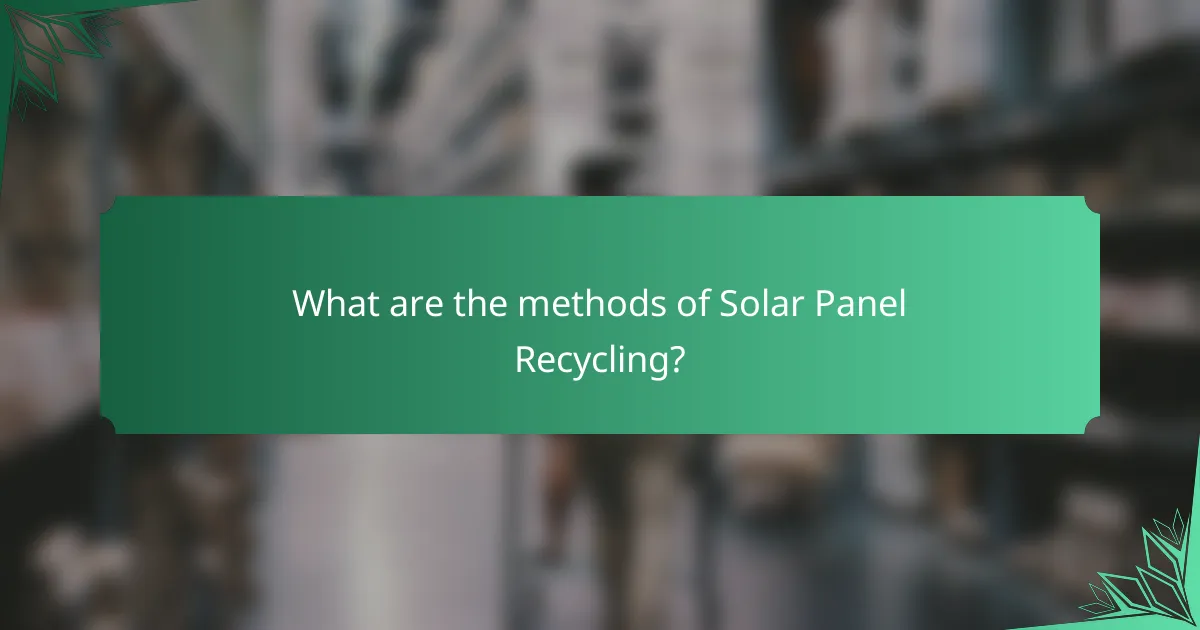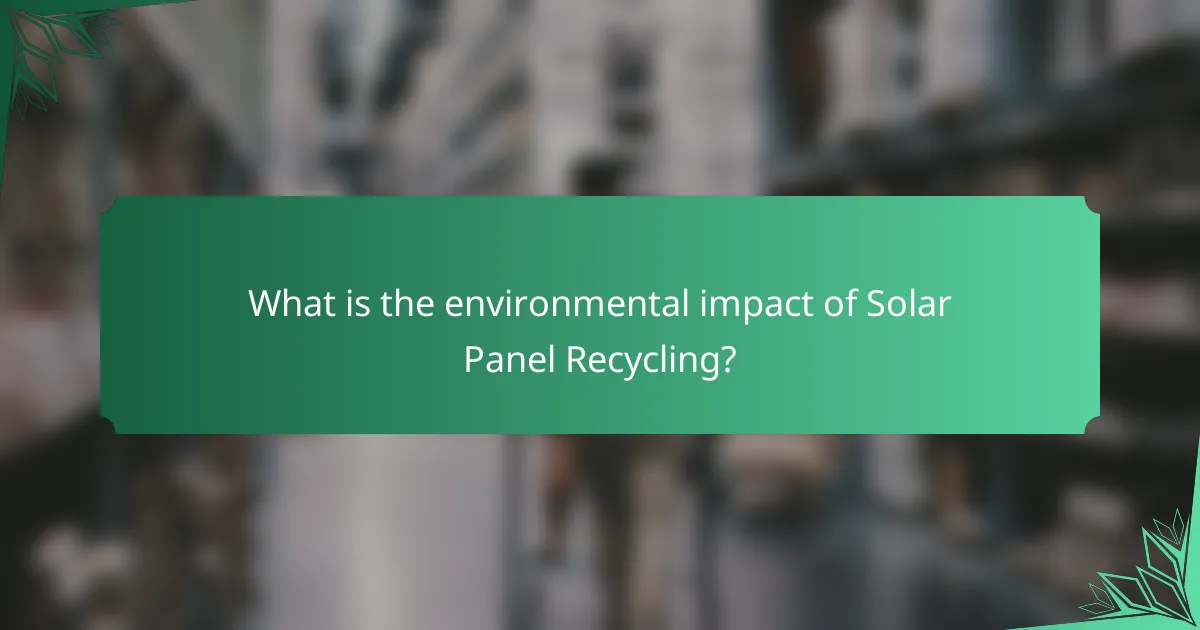
What is Solar Panel Recycling?
Solar panel recycling is the process of recovering valuable materials from used solar panels. This process involves dismantling the panels to extract metals like silver, aluminum, and silicon. The recycling of solar panels is essential due to the increasing number of panels reaching the end of their life cycle. In 2020, it was estimated that around 78 million metric tons of solar panel waste could be generated by 2050. Recycling helps reduce landfill waste and conserves natural resources. It also minimizes environmental impact by preventing toxic substances from leaching into the soil. Solar panel recycling contributes to a circular economy by reintroducing materials back into production.
Why is Solar Panel Recycling important?
Solar panel recycling is important because it prevents environmental pollution and conserves valuable resources. Solar panels contain materials such as silicon, silver, and rare metals. These materials can be harmful if disposed of in landfills. Recycling helps recover these materials for reuse in new panels. According to the International Renewable Energy Agency, 78 million tons of solar panels will reach end-of-life by 2050. Proper recycling can mitigate waste and reduce the need for mining new materials. This process supports a circular economy and promotes sustainable energy practices.
What are the environmental benefits of recycling solar panels?
Recycling solar panels significantly reduces environmental harm. It prevents toxic materials, like cadmium and lead, from contaminating soil and water. Recycling also conserves valuable resources. For instance, it recovers materials such as silicon, silver, and glass. These materials can be reused in new solar panels or other products. The process of recycling solar panels reduces the need for mining and manufacturing new materials. This leads to lower energy consumption and reduced greenhouse gas emissions. According to the International Renewable Energy Agency, recycling can recover up to 95% of the materials in solar panels. This demonstrates the significant environmental benefits of recycling solar panels.
How does recycling contribute to resource conservation?
Recycling contributes to resource conservation by reprocessing materials to create new products. This process reduces the need for extracting raw materials, which can deplete natural resources. For example, recycling aluminum saves about 95% of the energy needed to produce new aluminum from bauxite ore. Additionally, recycling reduces landfill waste, minimizing environmental pollution. It also conserves water and energy, as producing new products from recycled materials often requires less energy than using virgin resources. According to the Environmental Protection Agency, recycling and composting prevented the release of 186 million metric tons of carbon dioxide equivalent into the air in 2013. This demonstrates that recycling is a crucial component of sustainable resource management.
What materials are involved in solar panel recycling?
Solar panel recycling involves several key materials. The primary materials include silicon, glass, metals, and polymers. Silicon is the main component of solar cells, making up about 90% of the weight of a solar panel. Glass is used for the protective front layer and accounts for 10-20% of the panel’s weight. Metals such as aluminum and copper are used in the framing and wiring. Polymers are found in the encapsulant and backsheet. Recycling these materials helps recover valuable resources and reduces environmental impact.
What components of solar panels can be recycled?
The components of solar panels that can be recycled include glass, aluminum frames, and semiconductor materials. Glass makes up about 70% of a solar panel’s weight and is fully recyclable. Aluminum frames can be easily extracted and repurposed, reducing the need for new aluminum production. Semiconductor materials, such as silicon and other metals, can also be recovered and reused. According to the International Renewable Energy Agency, recycling solar panels can recover up to 95% of their materials. This process not only conserves resources but also minimizes environmental impact.
How are hazardous materials managed during recycling?
Hazardous materials in recycling are managed through strict regulations and specialized processes. These materials include lead, cadmium, and other toxic substances found in solar panels. Recycling facilities must follow guidelines set by environmental agencies. They implement safety measures to prevent contamination. Workers are trained to handle hazardous materials safely. Proper labeling and storage are essential to avoid accidental exposure. Advanced technologies are used to separate and neutralize these materials. This ensures that they do not harm the environment or public health.

What are the methods of Solar Panel Recycling?
The methods of solar panel recycling include mechanical recycling, thermal recycling, and chemical recycling. Mechanical recycling involves dismantling panels and separating components like glass, metals, and silicon. This method recovers about 90% of materials. Thermal recycling uses high temperatures to break down panels, allowing for the recovery of metals and silicon. Chemical recycling employs solvents to extract valuable materials, though it is less common. These methods aim to minimize waste and recover resources effectively. According to the International Renewable Energy Agency, recycling can significantly reduce the environmental impact of solar panel disposal.
How do different recycling processes work?
Different recycling processes for solar panels primarily include mechanical, thermal, and chemical methods. Mechanical recycling involves dismantling the panels and separating materials like glass, metals, and silicon. This process typically uses shredders and air classifiers to sort components effectively.
Thermal recycling employs heat to break down materials. This method can recover metals and glass, but it may release harmful emissions if not managed properly.
Chemical recycling involves using solvents or acids to dissolve specific materials. This process can extract valuable elements like silver and silicon from the solar cells.
Each method has its advantages and limitations. Mechanical recycling is widely used due to its efficiency, while thermal and chemical methods can recover more specific materials but may involve higher costs and environmental risks.
According to the International Renewable Energy Agency, effective recycling can recover up to 95% of materials from solar panels, emphasizing the importance of these processes in sustainable solar energy management.
What is the mechanical recycling process?
The mechanical recycling process involves breaking down materials into smaller pieces for reuse. It typically includes collection, sorting, shredding, and separation. In the context of solar panel recycling, this process targets materials like glass, metals, and polymers. First, collected solar panels are sorted by type. Then, they are mechanically shredded to liberate valuable components. Following shredding, materials undergo separation techniques, such as air classification, to separate glass from metals. This method is efficient and reduces waste. Studies show that mechanical recycling can recover up to 95% of valuable materials from solar panels.
How does thermal recycling differ from mechanical methods?
Thermal recycling involves the use of heat to break down materials, while mechanical methods utilize physical processes. In thermal recycling, materials are subjected to high temperatures, which can decompose or melt them. This method is effective for recovering valuable metals from solar panels. Mechanical methods, on the other hand, involve grinding or shredding materials to separate components. They are less energy-intensive but may not recover all valuable materials. Thermal recycling can achieve higher recovery rates for certain materials compared to mechanical methods. Studies show that thermal processes can recover up to 95% of metals in solar panel waste, while mechanical methods typically achieve lower recovery rates.
What technologies are used in solar panel recycling?
Technologies used in solar panel recycling include mechanical processes, thermal treatment, and chemical methods. Mechanical processes involve shredding panels to separate materials like glass, silicon, and metals. Thermal treatment uses high temperatures to recover valuable metals from the panel components. Chemical methods involve using solvents to extract materials, enhancing recovery rates. These technologies improve efficiency in recycling and minimize waste. For instance, a study by the International Renewable Energy Agency (IRENA) highlights that mechanical processes can recover up to 95% of materials from solar panels.
Which innovations are improving recycling efficiency?
Innovations improving recycling efficiency include advanced sorting technologies and chemical recycling methods. Advanced sorting technologies utilize artificial intelligence to identify and separate materials more accurately. This enhances the recovery rate of valuable components from recycled products. Chemical recycling methods break down materials at the molecular level. They allow for the recycling of complex materials that traditional methods cannot handle. For instance, these methods can reclaim rare metals from solar panels. According to a study by the National Renewable Energy Laboratory, these innovations can significantly increase recycling efficiency by up to 90%.
How do advanced sorting technologies enhance material recovery?
Advanced sorting technologies significantly enhance material recovery by improving the efficiency and accuracy of separating valuable materials from waste. These technologies utilize methods such as machine learning, artificial intelligence, and advanced sensors to identify and sort materials based on their properties.
For instance, optical sorting systems can detect different types of materials, including metals, glass, and plastics, with high precision. This leads to higher recovery rates of valuable components, such as silicon and silver, found in solar panels.
Research indicates that these technologies can increase recovery rates by up to 95% in some cases, compared to traditional methods. This not only reduces waste but also contributes to the sustainability of the recycling process. Enhanced material recovery through advanced sorting technologies ultimately supports the circular economy by ensuring that valuable resources are reused effectively.

What is the environmental impact of Solar Panel Recycling?
Solar panel recycling has a positive environmental impact. It reduces landfill waste by repurposing materials from decommissioned panels. Approximately 90% of a solar panel’s components can be recycled. This includes valuable materials like silicon, glass, and metals. Recycling these materials decreases the need for new raw materials. It also lowers greenhouse gas emissions associated with production. The process conserves energy compared to manufacturing new panels. Additionally, proper recycling prevents toxic substances from contaminating the environment. Thus, solar panel recycling contributes to a more sustainable energy future.
How does recycling solar panels reduce landfill waste?
Recycling solar panels reduces landfill waste by recovering valuable materials. About 90% of a solar panel’s components can be recycled. This includes metals like silver and aluminum, which can be reused in new products. Recycling prevents these materials from ending up in landfills. It also reduces the need for new raw materials, minimizing environmental impact. The U.S. generates over 1,000 metric tons of solar panel waste annually. Without recycling, this waste contributes to landfill overflow and environmental pollution. Thus, recycling solar panels is crucial for sustainable waste management.
What percentage of solar panels are currently recycled?
Currently, approximately 12% of solar panels are recycled. This statistic highlights the ongoing challenge in solar panel waste management. As the use of solar energy increases, the need for efficient recycling methods becomes critical. Research indicates that improving recycling rates can significantly reduce environmental impact. Many countries are developing better systems for solar panel recycling to address this issue.
How does recycling affect greenhouse gas emissions?
Recycling significantly reduces greenhouse gas emissions. It minimizes the need for new raw materials, which often involve energy-intensive extraction and processing. For instance, recycling aluminum can save up to 95% of the energy required to produce it from ore. This reduction in energy consumption directly correlates to lower carbon dioxide emissions. Additionally, recycling materials like glass and plastic also contributes to decreased greenhouse gas outputs. According to the Environmental Protection Agency, recycling and composting prevented the release of 186 million metric tons of carbon dioxide equivalent into the air in 2013. Thus, recycling plays a crucial role in mitigating climate change by lowering greenhouse gas emissions.
What challenges does Solar Panel Recycling face?
Solar panel recycling faces several significant challenges. One major issue is the complexity of solar panel materials. Solar panels contain various materials, including glass, metals, and semiconductors, making recycling processes complicated. Another challenge is the lack of established recycling infrastructure. Many regions do not have facilities capable of processing solar panels. Additionally, economic factors hinder recycling efforts. The cost of recycling can exceed the value of recovered materials, discouraging investment. Regulatory frameworks are also inconsistent. Different regions have varying regulations, complicating compliance for manufacturers. Finally, public awareness is limited. Many consumers are unaware of recycling options for solar panels, leading to improper disposal.
What are the economic barriers to effective recycling?
Economic barriers to effective recycling include high processing costs, lack of market demand, and insufficient infrastructure. High processing costs can deter recycling facilities from operating efficiently. Market demand for recycled materials often fluctuates, impacting profitability. Insufficient infrastructure limits access to recycling services, particularly in rural areas. These factors collectively contribute to low recycling rates. Research indicates that only 10% of solar panels are recycled globally due to these economic challenges.
How does public awareness influence recycling rates?
Public awareness significantly influences recycling rates by educating individuals about the benefits and processes of recycling. Increased knowledge leads to more responsible waste management behaviors. Studies show that communities with strong awareness campaigns have higher recycling participation rates. For example, a 2018 study by the Environmental Protection Agency found that public education initiatives increased recycling rates by up to 30%. Awareness also helps reduce contamination in recycling streams, making the process more efficient. When people understand what can be recycled, they are more likely to recycle correctly. This, in turn, boosts overall recycling effectiveness and sustainability.
What best practices can enhance Solar Panel Recycling efforts?
Implementing best practices can significantly enhance solar panel recycling efforts. Establishing clear recycling guidelines helps stakeholders understand proper disposal methods. Collaborating with manufacturers ensures that end-of-life panels are returned for recycling. Developing efficient collection systems increases the accessibility of recycling options. Investing in advanced recycling technologies improves material recovery rates. Educating consumers about recycling options raises awareness and participation. Tracking and reporting recycling rates can identify areas for improvement. According to the International Renewable Energy Agency, recycling can recover up to 95% of materials from solar panels.
How can consumers contribute to effective recycling?
Consumers can contribute to effective recycling by properly sorting their recyclable materials. This includes separating plastics, metals, and paper products. Consumers should also clean their recyclables to prevent contamination. Contaminated items can disrupt recycling processes. Additionally, consumers should stay informed about local recycling guidelines. Different areas have specific rules for what can be recycled. Participating in community recycling programs enhances overall effectiveness. Statistics show that proper sorting increases recycling rates by up to 30%. By taking these steps, consumers play a crucial role in promoting sustainable recycling practices.
What role do manufacturers play in promoting recycling initiatives?
Manufacturers play a crucial role in promoting recycling initiatives for solar panels. They are responsible for designing products that are easier to recycle. This includes using materials that can be reclaimed and reused. Manufacturers often establish take-back programs for end-of-life solar panels. These programs encourage consumers to return panels for recycling. Additionally, they may partner with recycling facilities to ensure proper processing. By investing in research, manufacturers can improve recycling technologies. This collaboration enhances the overall sustainability of solar energy systems. Such initiatives contribute to reducing waste and promoting a circular economy in the solar industry.
Solar panel recycling is the process of recovering valuable materials from used solar panels, including metals like silver, aluminum, and silicon. This article details the importance of solar panel recycling in preventing environmental pollution, conserving resources, and contributing to a circular economy. It explores various recycling methods such as mechanical, thermal, and chemical processes, as well as the technologies and innovations that enhance recycling efficiency. Additionally, the article addresses the environmental impact of recycling, the challenges faced, and best practices to improve recycling efforts, highlighting the role of consumers and manufacturers in promoting sustainable practices.